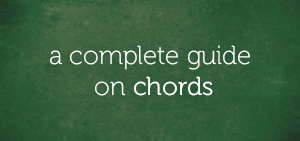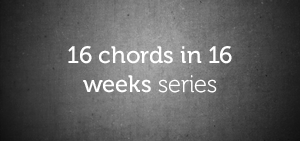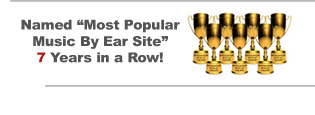Lately, we’ve been talking about power chords, tritones, and substitutions.
Today, I want to show you how to use tritones and minor chords to form crazy-sounding dominant ninth chords.
Yes, that means if you know all your tritones (…there’s only really 6 to learn) and all your basic minor triads, then you can play dominant ninth chords — instantly!
But not just any kind of dominant ninth chord. This voicing sounds really good!
As you know, two musicians can play the same dominant chord and make their versions sound totally different. I’m going to give you a “behind-the-scenes” look at how that’s possible.
Here’s the regular C dominant 9 chord:
C E G Bb D
It’s basically a C dominant 7 chord with an added “9” tone. If you don’t understand where the 9 comes from, read yesterday’s lesson.
There are only two steps to transforming this boring, “standard” ninth chord into a snazzy one!
Step 1: Play the tritone replacement for the dominant chord on your left hand. Remember, you can always substitute the appropriate tritone for a full dominant chord since a tritone utilizes the key tones of the dominant chord. Basically, take the 3rd and 7th tones out of the dominant chord and play them on your left hand. That is a tritone.
Example:
C dominant 9
C + E + G + Bb + DYou’d take out E and Bb and play them together.
* As you probably know, “E” is the third tone of the scale and “Bb” is the flat seventh tone.
So far, my left hand has “E + Bb” in it.
Step 2: After you have determined what tritone to play on your left hand, you’ll want to identify the 5th tone of the chord. You’ll want to play a minor chord off this tone on your right hand. If I’m playing a C9 chord, the 5th tone of C is basically G (which is in the chord). I’m simply going to play a G minor chord on my right hand.
It’s that simple! Find 5th tone of chord (or scale) and play its minor triad. Point blank!
Example:
C dominant 9
C + E + G + Bb + D*The fifth tone in C major is G. Therefore, I’m going to play a G minor on my right hand: (G + Bb + D)
You can try different inversions of this G minor triad but I prefer first inversion, which means the keynote will always be on top: (Bb + D + G)
Same for the tritone, you can try the alternate inversion but I like my flat seventh on the bottom (Bb + E) but feel free to try the other way around too (“E + Bb”). They both work.
So my full chord looks like this:
C dominant 9
Bb + E on left hand /// Bb + D + G on right hand
If you do use the opposite tritone “E + Bb,” you may find that the “Bb” from your tritone meets the “Bb” from your G minor chord if you’re playing both hands close to each other. This is fine. It actually results in a nice little effect with simply “E” on the left hand and “G minor” on the right hand.
Now here’s the best part.
In gospel music, you can really work this! Try going down a half step and doing the same thing. Then quickly move that chord back up to your original chord.
So basically, take this same exact voicing of C9 and move it down to B9.
If you understand “big picture thinking” (yesterday’s post), this shouldn’t be hard.
What is the tritone that goes with “B?” Bam! That’s your left hand!
What’s the 5th tone of B? Play it’s minor chord in first inversion! Bam!
B dominant 9
A + D# on left hand /// A + C# + F# on right hand*I’m using informal naming to make it easier to follow
And this B dominant 9 (a.k.a “B9”), which is the same exact chord as C9 (but moved down a half step), leads perfectly to the C9:
B dominant 9
A + D# on left hand /// A + C# + F# on right handC dominant 9
Bb + E on left hand /// Bb + D + G on right hand
In fact, if you play gospel music and know the classic “shouting” bass run:
C – E – F – Gb – G – A – Bb – B – C
*It’s a bass line so play each of these notes separately.
…Imagine playing this same dominant 9 voicing over each of these bass notes.
But here’s the thing — with this voicing, you don’t really play the bass. Either you rely on someone else playing the bass or you just play the chords rootless.
Imagine replacing each of those “shouting” bass notes with this dominant 9 voicing?
Try it! You already know the notes for C9 and B9.
Just take the same formula and match up the chords for each of these bass notes. Then practice playing them because it won’t be easy at first. You’ll love what you come up with! Sounds a little crazy at first but this is how top gospel musicians like Jason White and Michael Bereal think.
I hope you enjoyed!
Until next time —







Comments on this entry are closed.